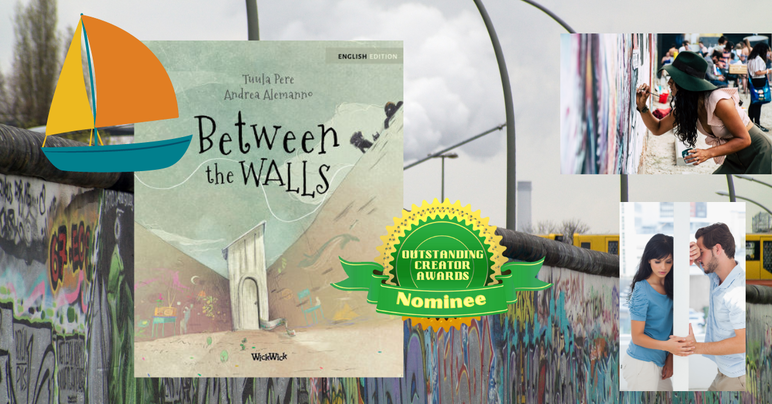|
Score: 94/100 (9.4 out of 10)
Between the Walls by Tuula Pere isn't your conventional children's book, but it provides such a powerful lesson for children and adults alike. It packs a huge punch! It's no surprise. Tuula Pere is arguably the most prolific children's author in the history of our contests: a multi-time overall winner. She isn't afraid to push the limits, break the conventions of storytelling for children, and dare to explore heavy/higher subjects like loss, depression, and even megalomania. In Between the Walls, Pere employs some very powerful Cold War imagery, alluding in particular to the separation of East & West Berlin by the Berlin Wall. This wall affected not just the people of Berlin and Germany, but the entire civilized world which was now divided between East & West—countries aligned with the USSR and countries aligned with NATO & the USA. So, the connotations of this are huge and far-reaching. This, obviously, isn't the only time in human history when groups of people were tragically and traumatically separated by a line in the sand. The 1947 partition of India led to the separation of India and Pakistan by geographic, cultural, and religious lines. Apartheid in South Africa led to the separation of people along racial lines. Gentrification and segregation in America see/saw the division of people along socioeconomic and racial lines. The demilitarized zone between North Korea & South Korea represents a decades-long war and the separation between democracy and totalitarianism—affluence and self-inflicted poverty. All of these things, like the Berlin Wall, led to widespread suffering and conflict between people who might otherwise get along under different circumstances. There are multiple reasons why people choose to be separated and divided from other people, some of them understandable (like a desire for individuality, sovereignty, independence, as well as for safety), but others petty like culture, religion, and race—or bitterness over something that happened a long, long, long time ago. With that said, this book is able to tackle this concept of people divided without it being over-the-top or disturbing to children. Instead, it's presented in a way that's friendly, somewhat funny, and digestible. We immediately see why a wall is erected to divide the city as disputes run amok regarding a pier they both share. A ship hoping to dock there ends up trying to dock on the wrong side due to bad weather (possibly fog), accidentally crashing into another ship. This incident ignites the powder keg of tension between the two sides of town who use it as a pretense to build a wall to keep the other side out. In fact, they technically each build their own wall with a “No Man's Land” in between, giving the book its name. After presumably years of tension and friends tragically and sadly separated on either side of the wall, a mysterious man named Leo arrives by sea, attempting to dock at the now-unkept and dilapidated pier. As an aside, this Leo may actually be the same boy/character from Pere's other book, Leo the Wanderer. Leo in that book was a boy who wandered from city to city, simply interacting with the people there, elevating their lives and spirits while learning a bit of things. The thought that this is an intertextual story that exists in the same universe as Pere's other books is incredible. Pere has such a great cast of characters who we'd love to see interact. How cool would it be for the blue crow from Only Blue Crow to fly past? How amazing would it be if Leo joined the circus from Mr. Cannelonni's Circus or if he were able to teach Felix the Fox to be a better person. It provides some continuity, something we appreciate. Anyway, after coaxing by one of the mayor's daughters, Leo is allowed to make a home in “No Man's Land”--the space between the walls. Using skills he presumably learned on his travels, he builds a small home and even grows his own crops. You know what's incredible: Leo the Wanderer wasn't a book that particularly scored well or won many accolades in our contests, but with this book in mind, it's incredible to see how much Leo grew as a person. Ultimately, Leo is able to inspire both sides of the town by showing them common things that they can all appreciate and enjoy: music, art, and recreation. We can just add “sports” to that “recreation” thing since some of the characters start dancing, swimming, and engaging in weight-bearing activities together. This is actually a tremendously impressive story with some great character work. The only things that really holds this book back are the slight wordiness and the fact that the art isn't spectacular. However, maybe it didn't need to be. It fits the art of Leo the Wanderer. Though it lacks color, that actually might help to tell the story because the things that are colored are things that are to be emphasized. For example, the art on the sidewalk and Leo's clothing are colored while the other characters are plain and drab. This poetically shows that Leo is bringing color and light to this town. If you need an inspiring story with higher themes for more advanced children, check this out on Amazon!
0 Comments
Leave a Reply. |
Archives
July 2024
Categories |

 RSS Feed
RSS Feed